
Telling ocean science stories on social media
This is the blog version of our iPoster for the 2020 Ocean Sciences Meeting. “Our” means the fun team consisting of Torge Martin, myself, Elin Darelius, Yasmin Appelhans — my #KitchenOceanography and science communication buddies! :-)
Torge is presenting the poster in San Diego today, but since none of us others could be there (and maybe you can’t see him present, either), here we go! (Or, alternatively, see it in all it’s glory as iPoster the way it’s meant to be)
Training students to communicate science
Why communicate science?
We believe that “science isn’t finished until it’s communicated”(Sir Mark Walport). Scientists have a moral obligation to society to not only answer scientific questions, but to make their findings available to the public, who funds the research in the first place.
Why train students?
Better learning
By giving students the opportunity to talk in layperson’s language about concepts they are currently being taught, we are providing them with a learning strategy that helps them think about the concepts in a different way and better connect it to preexisting knowledge.
Career development
Talking about specialized topics to laypersons is a skill that students will utilize throughout their lives, whether as future researchers or teachers, politicians or citizens. Learning this skill already at university is beneficial for their career development.
Authentic connections
Reaching any audience is easiest when the person reaching out has a good grasp of the interests, habits, life styles of that specific audience. For an audience of young adults, the most authentic narratives are thus told by students, “relatable heroes”. Even audiences that might not be intrinsically motivated to seek out content on ocean sciences can be reached with ocean education and outreach topics when met where they like to spend their time.
How to train the students?
The setting
We train Bachelor students in Climate Sciences in communicating with a lay audience in a clear and easy to understand, yet entertaining and engaging way. Mandatory, peer-reviewed course reports, for example on training cruises on research vessels, or on hands-on experimentation in fluid dynamics laboratories, are specifically written for the purpose of communicating science content as well as students’ enthusiasm and passion for the subject.
The training
For different courses, different training concepts were used. For example, science journalist Dr. Yasmin Appelhans gave a presentation with practice opportunities plus feedback on finished products in a GFD class at GEOMAR.
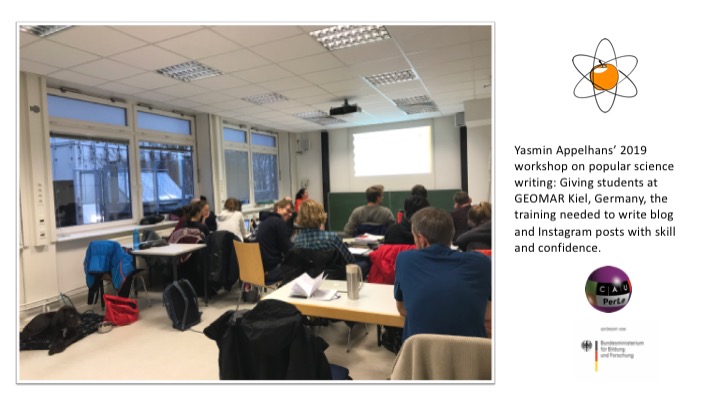
Connecting on popular platforms
Why Social Media?
We use Social Media as a tool that enables communication with young audiences in a space they come to for entertainment and community. Rather than trying to establishing a profile and build a community of followers ourselves, we make use of guest posts on, and takeovers of, selected popular accounts. We thus reach a broad audience that might, once exposed, find themselves interested in the topics and might pursue that interest further on other channels, such as our blog. We discuss our experiences with this approach as well as chances and potential pitfalls.
What Social Media?
Instagram is the most frequently used social media platform in the age range of our students and target audience. We therefore use guest posts and takeovers on accounts that our target audience follows, for example
@nordicpolarsciences, made by and for Master- and PhD students in Nordic Polar Sciences at the University of Bergen.

@kieluni, the official account of Kiel University, Germany.
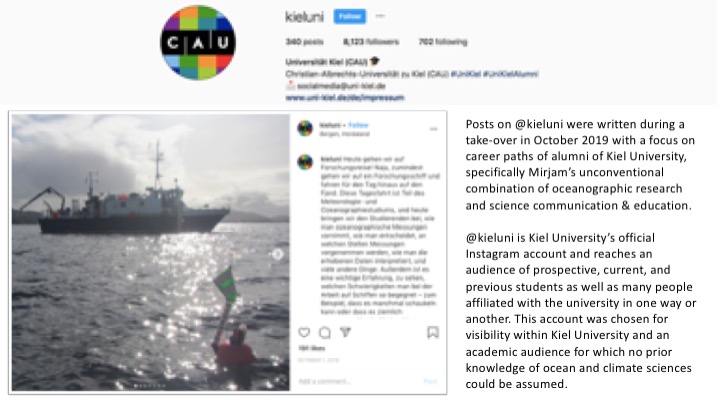
@doktorwissenschaft, a famous German science communication account for a young audience.
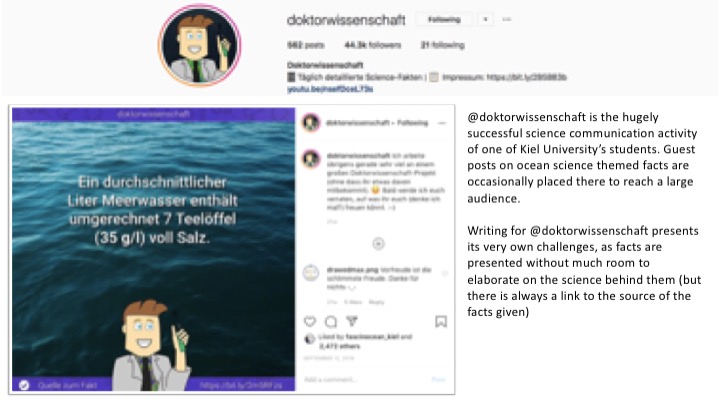
Youtube
Another hugely successful platform in our target audience’s age range is Youtube, and movies are a way to elaborate in much more detail on science concepts. One example is the noteworthy collaboration with DoktorWissenschaft on bringing oceanographic phenomena to an audience of young viewers.
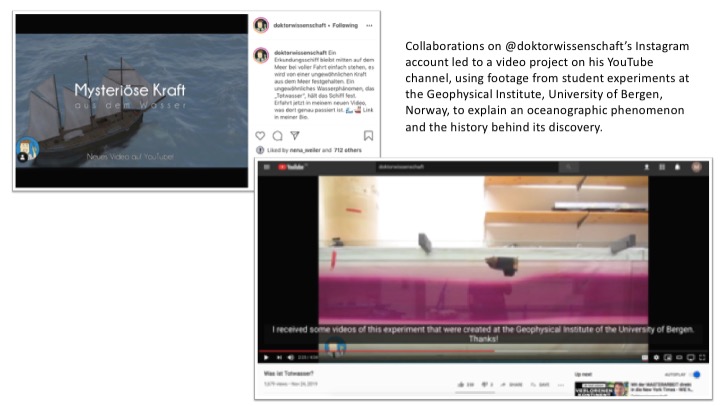
Blogs
We also use blogs to
- create a lasting archive of our social media outreach efforts on a platform we fully control
- reach more traditionally-minded science audiences (e.g. colleagues, funders)
- reach audiences we have already established on those platforms and that are hard to transfer to e.g. Instagram
In addition to guest posts, we use three blogs for slightly different reasons.
“Teaching Ocean Science” is hosted by GEOMAR’s OceanBlogs and was initiated by Torge Martin to document the project “Dry Theory to Juicy Reality” as well as other teaching innovations at GEOMAR, through blog posts written both by instructors and students.
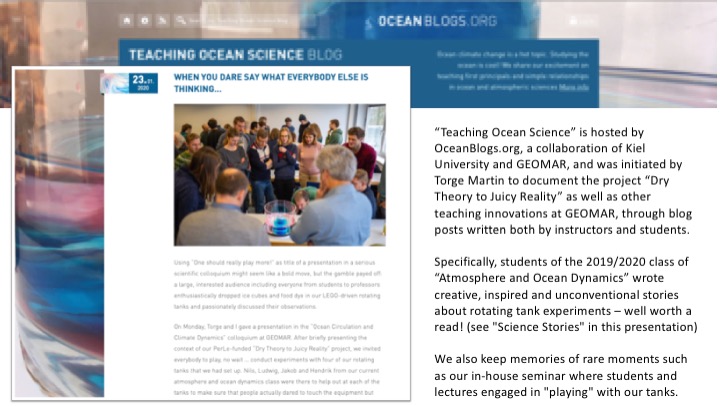
“Scientific Adventures of Elin Darelius & Team” documents Elin Darelius & her team’s scientific life as well as teaching improvements. Posts are written both by instructors and students.

“Adventures in Oceanography and Teaching” is Mirjam Glessmer’s blog where she gives science communication & education advice, especially focused on “kitchen oceanography”. Posts are mainly written by her. We use this blog to reach other ocean educators and share our experiences.
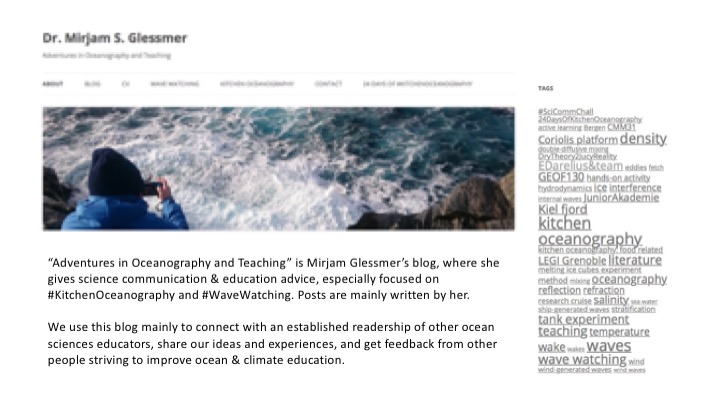
Science Stories
Most of our science stories are related to doing experiments in water tanks to simulate the ocean and atmosphere. Since the mathematical descriptions of ocean and atmosphere dynamics are difficult and unintuitive, we use those tank experiments to give students a tangible experience with the processes as well as the opportunity to manipulate conditions and get a better grasp of the matter at hand.
Within the project “Dry Theory to Juicy Reality”, students wrote science stories using very individual and unique approaches ranging from a diary style…

…to the fictitious story of Romeo and Juliette, two water drops that go through a lot of drama caused by cooling in a rotating water tank, simulating atmospheric instabilities…

…to the historical approach of how a process was understood over centuries of research…

…and to detailed physical explanations of Rossby waves.

Our team
Dr. Torge Martin (Kiel, Germany) teaches Ocean & Atmosphere Dynamics

Dr. Mirjam S. Glessmer (Kiel, Germany, and Bergen, Norway) works on improving ocean science communication and education

Dr. Elin Darelius (Bergen, Norway) teaches different topics within oceanography, both in lecture theatres, in the lab and at sea

Dr. Yasmin Appelhans (Kiel, Germany) gives workshops on how to effectively communicate science

Thanks!

Evaluation rubric for Instagram posts (in scicomm and/or science classes!) - Adventures in Oceanography and Teaching says:
[…] explained why I think that that is generally a good idea in our recent virtual poster, but here is an even more recent example of how well it can work: In early April, Prof. Tessa M […]
Teaching field courses in a virtual setting - Adventures in Oceanography and Teaching says:
[…] into your assessment that are motivating students in themselves, for example asking them to write Instagram or blog posts (and check out this blog post for a grading rubric for Instagram […]
Thinking about Storytelling in Teaching for Sustainability - Adventures in Oceanography and Teaching says:
[…] follows one or more persons* (in the widest sense, can also be for example animals or robots. Or water parcels in this example from our own teaching!). There are typical ways stories are told (for example a hero’s journey or a fairy tale) and […]